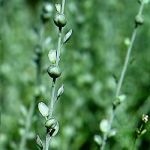| Common Name: |
Broad-Leaved Cress |
| Other Names: |
Cress |
| Botanical Name: |
Lepidium sativum |
| Genus: |
Lepidium |
| Family: |
Brassicaceae |
| Location: |
W Asia; widely naturalized. |
| Cultivation: |
Well-drained soil in sun or partial shade. |
| Propagation: |
By seed sown from spring to early autumn in cool areas, from autumn to early spring in areas with hot, dry summers, or at any time under cover. When growing as "mustard and cress" for salads, sow 4 days earlier than mustard so that the cotyledons or seedlings are ready at the same time. |
| Harvest: |
Leaves are cut at seedling stage or when young and used fresh. Flowering tips are picked for salads. Seed pods are collected when unripe and used fresh or dried. Seeds are harvested when ripe and used whole or pressed for oil. Roots are dug in autumn and used fresh. |
| Height: |
20-40cm (8-16in) |
| Width: |
7-15cm (3-6in) |
| Variations: |
Broad-Leaved
Has oval, undivided leaves, to 5cm (2in) long. Ready in 10-40 days; good for soups. |
Curled
Has finely divided leaves. Ready in 10-30 days; good for salads and garnishing. |
Greek
Is fast growing, with an excellent peppery flavor. Usually grown outdoors, sown in succession. |
Persian
Syn. Barbeen, shahi
Has broad, toothed leaves, 5-15cm (2-6in) long; popular in the Middle East as a garnish and potherb. |
|
| Hardiness: |
Hardy |
| Parts Used: |
Cotyledons (seed leaves), young leaves, flowers, seed pods, seeds, roots. |
| Properties: |
A strong-smelling herb with a pungent flavor. Leaves have tonic and diuretic effects. Seeds are stimulant, laxative, and diuretic, with carminative and expectorant effects; they stimulate the uterus and increase lactation. |
| Medicinal Uses: |
Internally, in Ayurvedic medicine, for skin diseases, hiccups, coughs, asthma, flatulence, indigestion, diarrhea, debility (infusions of seeds), and externally for skin diseases, rheumatic pains, sprains, dislocations, and bruises. Not given during pregnancy. |
| Culinary Uses: |
Fresh leaves give a piquant flavor to salads, sandwiches, soups, omelettes, and herb butters; also used as a garnish, like watercress. Flowers are added to salads. Fresh or dried pods are used as seasoning. Roots are used as a condiment, similar to horseradish. |
| Bibliography: |
Encylopedia of Herbs by Deni Brown Copyright ©: 1995, 2001 Dorling Kindersley Limited pg.259
|
